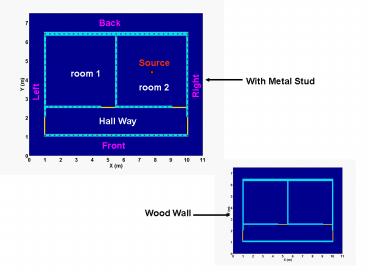Source - PowerPoint PPT Presentation
Title:
Source
Description:
Estimation Errors due to multi-path propagation delay: F= 433 MHz: Wood Wall: Maximum Error=0.4m for distance=7.6m. Wall with metal studs: Maximum ... – PowerPoint PPT presentation
Number of Views:28
Avg rating:3.0/5.0
Title: Source
1
Back
Source
room 1
With Metal Stud
Right
room 2
Left
Hall Way
Front
Wood Wall
2
Simulation Configuration
- Simulation Geometry
- Two Rooms 4mx4.5m each
- Wall
- conductivity 0.0005 S/m
- Permittivity 10 ?o
- Thickness 12 cm for inner wall 20 cm for outer
wall. - Wood Door
- Conductivity 0 S/m
- Permittivity 42 ?o
- Cross-section 90cmx6cm.
- Metal Stud
- Conductivity 107 S/m
- Permittivity ?o
- Cross-section 5cmx8cm
- Stud spacing 30 cm
- Simulation Facts
- Grid resolution 1.0 cm 1100x750 grids are used
in XY plane. - Time step 6.0e-11 sec. Radiation source is placed
at the center of the right room. - Scenario 1
- Sinusoidal current source with f 433 MHz.
- Jz ? Sin(2?ft) for sec
- Then, switch to 0 for the rest time.
- Both with and without metal wall studs are
simulated - Scenario 2
- Sinusoidal current source with f 433 MHz.
- Jz ? Sin(2?ft) for sec
- Then, switch to 0 for the rest time.
- Both with and without metal wall studs are
simulated
3
Average Power Map (Sum and average)
433MHz Wood Wall
433MHz With metal Stud
4
Average Power Map
2.4GHz Wood Wall
Metal Studs cause interference pattern. Leaking
power is generally less for wall with metal
studs. Leaking power for 2.4Ghz excitation is
larger.
2.4 GHz With metal Stud
5
Detecting Emitted Signal and Estimating Distance
Detect First Dip
Delay for signal to subside
6
Wood Wall f 433 MHz
Wall with Studs f 433 MHz
Monitoring Points We place monitoring points on
4 sides outside the wall 0.5m to the wall, 1.0m
apart. We record the arrival time of the first
dip in the received signal at the monitoring
point. Plots The delay time dt is used to
estimate the distance between the transmitter and
receiver by using c x dt. In the above plots We
plot estimated distance vs. actual distance with
color-coded symbols. The color represents the
monitoring points on different sides as indicated
in the legend. The blue line show the scenario if
the estimated distance equals actual distance.
7
Wood Wall f 2.4 GHz
Wall with Studs f 2.4 GHz
Estimation error is different for monitoring at
different sides. Estimation Errors due to
multi-path propagation delay F 433 MHz Wood
Wall Maximum Error0.4m for distance7.6m.
Wall with metal studs Maximum Error0.9m for
distance8.3m. F2.4 GHz Wood Wall Maximum
Error1.0m for distance8.3m. Wall with
metal studs Maximum Error1.4m for
distance8.3m. Error can be minimized by
monitoring from optimized location and use
magnitude info. (Stronger signal means closer to
the source near side is with less error.)

